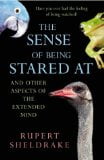 The Sense of Being Stared at: And Other Aspects of the Extended Mind
The Sense of Being Stared at: And Other Aspects of the Extended Mind
by Rupert Sheldrake
Arrow Books, £7.99 (pb), ISBN 0099441535
Readers of The Skeptic will know of Rupert Sheldrake’s work and the robust defence of it he is capable of mounting when the occasion arises. The Sense of Being Stared At continues his exploration of psi faculties, but the thesis is by now a familiar one.
The subtitle should not be overlooked because Sheldrake writes about much more than the staring effect, though it acts as a clear illustration of his argument that minds are not confined to brains but are capable of reaching out into the world and interacting with each other. He ties telepathy, clairvoyance and precognition together as components of a general ability affecting, in some unspecified way, not just human but also nonhuman animals. Unfortunately this involves repetition from his earlier books, notably Dogs That Know When Their Owners Are Coming Home (not There, Arrow blurb writer).
The range of research outlined here and its apparent success, not to mention the ease with which he has seen off the often shoddy attempts by critics to demonstrate that his methods are flawed, indicate that Sheldrake’s experimental work needs to be taken seriously. The large number of anecdotes he includes, however, though useful in suggesting lines of research, do not strengthen his case as convincingly as he seems to think they do.
Sheldrake includes a variety of straightforward experiments for readers to try, with instructions on how to send him their findings. He has been very successful in encouraging the public to take up his invitation, but using data obtained in this way raises a quality issue. One also yearns for a more rigorous theoretical underpinning to his results. There is much to think about, but a great deal more strictly controlled work would need to be done before Sheldrake’s hypotheses could be accepted by the wider scientific community.
Tom Ruffles

